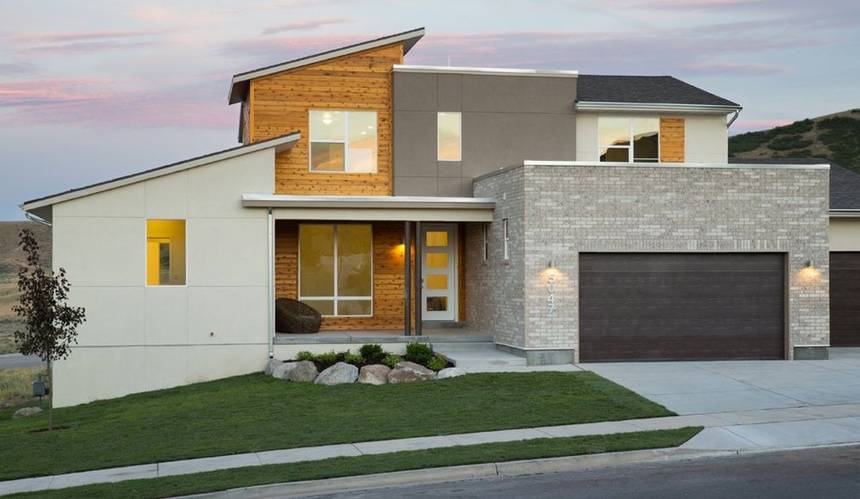Net Zero Homes – Are They The Wave Of The Future?
Net Zero homes are rapidly growing for good reason – they free you from utility bills! Image © Zero Home
Guest Article by Brad Ormsby
One of the biggest parts of everyone’s family budget is the power bill. But what if there was a way to eliminate this bill altogether? While this may sound fishy to some, it’s not only possible, but going on in thousands of households all across the country. This is all thanks to net zero energy homes.
So, what are the most important questions to answer before becoming a net zero homeowner?
- What Are Net Zero Homes?
- How Is A Net Zero Home Different From Traditional Designs?
- How Much Does A Net Zero Energy Home Cost?
- What Are The Benefits Of A Net Zero Home?
- What Upgrades Can Be Made To Move Your Home Closer To Net Zero?
We’ll answer all of these questions below. Let’s jump in…
What Are Net Zero Homes?
Net zero energy homes do not necessarily have to be off the grid. In fact, most are still grid tied as a form of backup in case of emergency.
The true meaning of a net zero energy building is one that produces as much power as it consumes. This means that they can still consume power from the grid in some cases, and then overproduce power on their own which exports to the grid at others.
The net sum of this is that the electric meter in a net zero energy building moves neither forward or backward. This is achieved most commonly through the use of renewable energy systems, battery storage, and highly efficient electrical home lighting and appliances.
How Is A Net Zero Home Different From Traditional Designs?
Net zero homes may not look drastically different from a traditionally designed home, but they certainly operate differently. The first commonality between most net zero energy homes is that they will largely face south. This is for two very important reasons. The first is that southern exposure to the sky maximizes potential solar output. Facing solar panels south in the northern hemisphere will provide more electricity production than in any other direction.
The second reason is for purposes of passive solar. Passive solar is the act of allowing natural light into your home for the purposes of heating without using a fuel source. The light, let in through large windows, heats dark surfaces which allow the home to stay warmer and require less energy to both heat and cool.
Additionally, net zero energy homes will sometimes contain a battery bank which serves as a backup power source. This is especially common in homes that are off the grid and rely on renewable energy sources exclusively to power the home. Despite these internal differences, the physical structure of these homes are not at all different from traditional designs.
How Much Does A Net Zero Energy Home Cost?
The cost of a net zero energy home is entirely dependent on its size. That is largely because it takes far less energy to power a smaller home than it does to power a much larger one.
The best way to normalize this cost is to put it in terms of cost per square foot of livable space. Many experts in net zero energy buildings estimate the cost of such a structure to be roughly five to ten dollars per square foot higher than a comparable home with a more traditional energy design. This means that for a traditional 2,000 square foot home that costs $250,000, a similar net zero model of the home would cost about $265,000. While this price increase may seem substantial to some, the return on investment is quickly met by eliminating energy bills almost entirely.
What Are The Benefits Of A Net Zero Home?
There are a variety of benefits of net zero energy homes ranging from economic, environmental, and societal.
From an economic standpoint, once the home has shown a viable return on its investment in the form of lower or entirely eliminated energy bills, homeowners are essentially using power for free.
Second, the environmental benefits cannot be understated. The average home emits roughly 15,000 pounds of carbon dioxide and other harmful greenhouse gasses per year. By utilizing a net zero building design, all of these emissions are kept out of our shared atmosphere.
Finally, the societal benefit to you as a homeowner is the security that this type of home can provide. Because you produce all of your own power, you never have to rely on your local utility to make sure you have power in times of crisis. The combination of all these benefits have made net zero energy homes an easy choice for thousands of homeowners every year.
What Upgrades Can Be Made To Move Your Home Closer To Net Zero?
There are many upgrades that can be made to your home in order to move it closer to a net zero energy building. Because a net zero home relies on producing just as much energy as it consumes, homeowners will have to invest in some kind of renewable energy generation.
The most common type of renewable energy generation is solar. A solar system which is sized large enough will meet the entire demand of a home. Thanks to net metering policies in many states, the excess power that the system produces can be exported to the grid. Homeowners will then receive net metering credits towards their electric bill even further lowering the cost.
Additionally, homeowners can make changes within the home that will help to lower energy demand as well. The less energy that a home consumes, the smaller a rooftop or ground mounted solar system can be which powers the entire home.
Great examples of these interior changes are Energy Star appliances.
These appliances have been specifically designed to use less energy without compromising its intended function. This means your laundry will still get done and the dishes will still be clean just without using as much energy.
Finally, one of the best returns on investment from an energy efficiency standpoint comes from lighting. Not only do LED lights shine brighter than traditional light bulbs, but they also last far longer which saves you money over time. With each additional upgrade, homeowners begin to move closer to living in net zero energy homes.
Net zero energy buildings may not make sense in all areas of the country. But, thanks to a bigger emphasis on sustainability and the growing return on investment for going green, the popularity of these structures is on on the rise. So, before paying your next energy bill, feel free to do more research on your own to see what upgrades can be made to your home in order to make next month’s bill even lower.
 Brad Ormsby – Brad works for SunPower by The Solar Quote, a Stockton CA solar company. He enjoys writing about solar energy, living green, and reducing our impact on the environment. You can find some of his other work on solar energy here.
Brad Ormsby – Brad works for SunPower by The Solar Quote, a Stockton CA solar company. He enjoys writing about solar energy, living green, and reducing our impact on the environment. You can find some of his other work on solar energy here.








